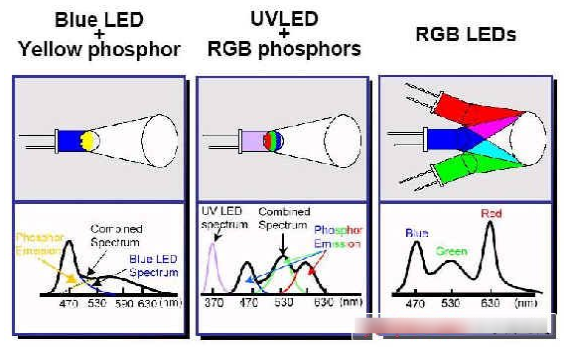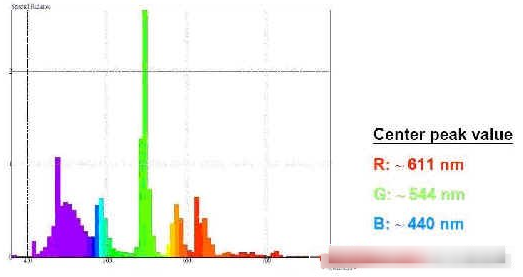However, while everyone has their own preferences, the trade-off between technology and cost is not so simple. Some compromises cannot be made. Whether it's frequency or voltage consistency, if there's no adjustment, the resulting light is likely to be completely uncontrollable. Therefore, both technologies are being developed and each has its own market. Whether the market determines the technology, or the technology drives the market, will likely spark considerable debate.
RGB Color Dominates
Those who appreciate high-definition images will readily notice that the colors produced by some LED backlight panels are exceptionally clear and vibrant, even rivaling those of high-definition televisions. This is precisely the hallmark of RGB, which boasts the characteristic of red being red, green being green, and blue being blue. It offers a wide range of color mixing properties, just like a painter's palette, allowing for the most immersive and captivating use of color. It perfectly presents the most authentic and colorful world, embellishing our lives.
Mei Guangyuan General Manager Lin Zhuxuan, who announced the abandonment of white LED production lines based on the perceived lack of future prospects for phosphor-based white LEDs, specifically pointed out that light attenuation isn't the only issue, but other factors are also a major contributing factor. He clearly stated that white LEDs significantly lag behind RGB in clarity and color purity. He also stated that with proper overlap, RGB can achieve an overall brightness and clarity five times that of phosphor-based white LEDs. Furthermore, light attenuation and the high cost of wafers are key factors in his optimism about RGB lighting.
Furthermore, RGB has significantly more diverse applications than white light LEDs. For example, he cited car lights, traffic signs, and store windows as examples. When specific wavelengths are needed, RGB color mixing allows for unrestricted color mixing, which disadvantages white light LEDs. Therefore, the resulting image quality is naturally superior.
However, how do RGB lights actually create images? Tsai Cheng-ta of the Electronics and Optoelectronics Research Institute at the Industrial Technology Research Institute (ITRI) explained that RGB lights use the intersection of the three primary colors to create an image. There are also blue LEDs combined with yellow phosphors, and ultraviolet LEDs combined with RGB phosphors. Overall, both have their own imaging principles, but the issues of attenuation and the effects of ultraviolet light on the human body are difficult to resolve in the short term. Therefore, while both can meet the requirements for white light, they produce different results.

Figure 1: White LEDs use different color-producing principles, which in turn affects overall performance.
White LEDs reflect cost.
Although phosphor-based white LEDs are not immune to color fading, they have a niche in the market. The most important factor is cost!
One LED outperforms three, and this is the key to their market dominance. Zhang Hongwei, Business Development Manager for High-Performance Analog Products at Texas Instruments (TI) China, stated that RGB lights are currently significantly more expensive than white LEDs. Their only competitive advantage lies in backlighting, where they may compete with white LEDs in the future. Other applications are currently primarily auxiliary lighting. Another major issue with RGB lights is response time. Currently, most RGB lights have a response time of approximately 4-8ms. He stated that if he were to visit a hypermarket and see all RGB lights with a response time of 1-2ms, the era of RGB lights would be upon us.
However, he also stated that a lack of proficiency in color mixing technology can lead to failure. After in-depth analysis, he pointed out that adjusting color temperature is often the most difficult part. When the color temperature is high, the overall color tone tends to be cooler, while when the color temperature is low, the overall tone tends to be warmer. Therefore, excellent color mixing skills are essential, otherwise significant problems will arise.
Why do these problems arise? They primarily stem from the frequency and wavelength of the three colors. Qi Zinian, senior project manager in the Application Engineering Department of Agilent's Electronic Measurement Group, explained that red light has the lowest frequency and the longest wavelength, reaching 611nm. Green light is next, reaching 544nm. Blue light is the shortest, at only 440nm. Under these circumstances, packaging the three RGB chips together naturally presents problems.
Therefore, he stated that while separate RGB control allows for direct control and good color mixing, achieving a pure white light is a major challenge. While this is expensive, the quality is relatively good. Regarding white LEDs, while they are inexpensive and can directly replace CCFLs and become the primary LED technology, the wavelength and frequency of the light emitted by these LEDs can be relatively unstable due to the packaging.
However, RGB lighting still needs improvement in terms of control. For example, if one LED fails, it will be noticeable across the entire screen. Conversely, white LEDs can compensate for a failed LED due to their side-effect relationship, and the resulting color mixing is uniform, ensuring a smooth overall appearance.

Figure 2: Red, green, and blue, with different wavelengths, will cause instability when packaged on the same die.
RGB or CMYK
Now that we have three colors, some may wonder whether this color mix, which some art publications use as their base color palette, can also be applied to white LEDs. Qi Zinian explained that the existing RGB method is primarily based on wavelength across the entire spectrum. The concept of CMYK differs from RGB, primarily because the backlight primarily reflects light, which RGB can achieve. However, while CMYK generally achieves higher saturation based on imaging principles, its chromaticity is equivalent to a conversion of RGB coordinates, and the resulting color may not be ideal. As far as he knows, he has not heard of such a method currently on the market.
To address the issue of RGB frequency mixing, Zhang Hongwei stated that there are currently emerging market approaches that use color filters for post-filtering integration. These primarily utilize RGB, or even RGB plus black, color mixing. This is primarily due to the varying response times of the three RGB colors. In the future, if the RGB three-color response time can be ideally reduced to 1-2ms, it should be more cost-effective, as accurate color mixing can be achieved without the need for color filters. Currently, color filters are primarily controlled by the United States, Japan, and other countries, so technological advancements could help break these countries' monopoly on filters.
Furthermore, he noted that many specialty stores currently sell customized lighting sets tailored to each household's color needs. Whether it's color adjustment or light filtering, this approach provides greater customization flexibility, diversifying household lighting fixtures and stimulating market demand for various conversions.









